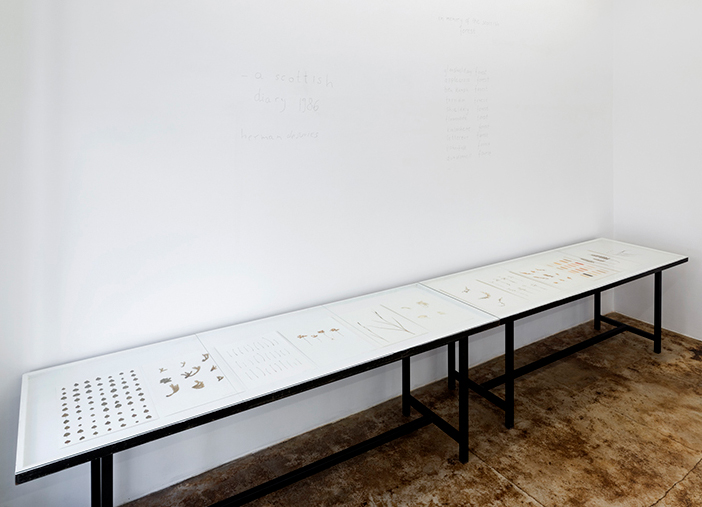journals
[91] In his many journeys to other places in the world, however exotic or remote those places may seem to be, it is what de vries prosaically calls the 'facts' that make their way into the journals that he creates as a documentation and a record. As with the seeings of my beings, it is what singles itself out from the infinite diversity of possibilities that is caught in the frames of the journals, which are composed of random samples thus encountered in whatever place the artist finds himself at a given moment. How could any plant, blade of grass, leaf, shell, rabbit dropping or earth specimen be more significant than any other? Every natural object is like Blake's 'ev'ry bird' - 'an immense world of delight'. 'If the doors of perception were cleansed' wrote Blake elsewhere, thinking of the 'clos'd senses five', 'every thing would appear to man as it is, infinite.' For de vries, the opening of the senses - sight, hearing, touch, taste and smell - and the consequent expansion of consciousness are primary purposes of art.
[...]
[95] On the title page to his diary of a visit to pashupatinath, january-february 1989 de vries appends a further note: with some additional facts from kirtipur, patan, nagarkot vajra bahini, kathmandu and pokhara. This elaboration serves both to make for accuracy of record and to enact in the procession of names the progression of his journey. But by his simple description of the entries in the journal as 'facts' - they include, as do all the journals, plant specimens, fronds and single leaves, earth rubbings, photographs of natural objects and cultural artefacts - de vries is subverting the Wittgensteinian distinction so baldly stated in Tractatus 1.1: 'The world is the totality of facts, not of things.' Things, for de vries, are facts, and contra Wittgenstein (Tractatus 1.2), 'the world' does not 'divide into facts' but is composed of things. They may fall into generic categories but the things here present in the journals are of a specific place collected at a particular time: Mouans-Sartoux (1991), Leros and Patmos (1996), l'Île Sainte Marguerite (9th April 1997), Gomera (2000), Eschenau (2002), etc.
Of course, the many entries in the many journals constitute an ever-growing conglomeration of singular reminders: "everything" de vries remarked to Nesbit, "represents always something." To commemorate, make memory possible, and to communicate something to others of the flow of an individual experience, are the principal motives for making a diary. de vries also conceives of the artist as the journeyman rememberer for the tribe (as we shall see, to keep alive memories of important things is the very purpose of his great documentary work, natural relations). Travelling in Scotland
[96] for the first time in 1985 (when he made his first journal, scottish diary) de vries noted on the maps the names of many forests. "but when i visited these places, i found not forest but moorland, or grazing land. [the great caledonian forest that covered the biggest part of scotland was almost completely destroyed for timber, and in the first place to make charcoal for smelting iron ore. this happened after the occupation of scotland by the english.] realising the impoverishment of this landscape, i studied all the topographical maps and made the text of a book, in memory of the scottish forests, containing the names of all those lost forests. but with a book you don't get back a forest." Those absent forests can no longer be walked in, experienced by the sentient being: they remain only in word-traces on maps. At Inverleith House, the moving litany of their names was inscribed on the gallery wall in charcoal - a trace of wood transformed by fire - carrying in this case a particular poignancy. It was a temporary monument to lost local things, itself soon to be erased.
source: Mel Gooding, herman de vries. chance and change (Thames and Hudson : London 2006) 91-96.

